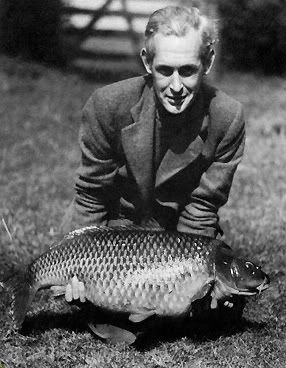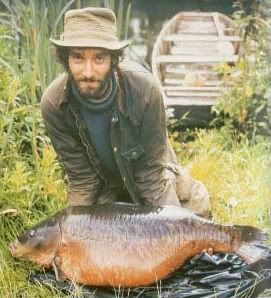All week I have been laid low by a diabolic illness. To make matters worse it is not the kind of illness which allows a couple of surreptitious days on the river bank; but it has kept me from work. To distract me while the malaise runs its virulent course I have taken the opportunity to re-read a couple of classics from angling’s literary canon.
First was Richard Walker’s Still Water Angling, first published in 1953. I read this book as a boy, choosing it as one of the weekly library picks we were obliged to take at school but, I’m ashamed to say, I can’t remember it making much of an impression. I recently purchased a copy of the fourth edition (David & Charles, 1975) and have been looking forward to reading it as an older and, hopefully, wiser angler.
Still Water Angling is often cited as seminal in that it states big fish may be caught more by design than luck. As a result the cult of specimen hunting was spawned. My impression, though, was that for all the precise instruction contained within the book, Walker’s ethos can be distilled into a basic set of rules based upon fundamental principles:
a) Locate big fish
b) Do not alert them to your presence
c) Present a bait to them when they are most likely to be feeding - taking the prevailing conditions into account
d) Ensure the tackle used is suitable to the job in hand
It is amazing how, fifty-odd years on, these basics are still ignored by many. Last summer, during a (thankfully brief) shower, I was almost blinded by the glare from a carp angler’s fluorescent orange Hi-Viz jacket.
Each chapter in Stillwater Angling deals with a specific species with, not surprisingly, almost half the book given over to carp, including the author’s account of the capture of his ‘44’. I enjoyed re-reading the book immensely, despite a narrative style which veers seamlessly between avuncular on the one hand, and hectoring on the other. But then, Walker could - and often did - boast a remarkable list of achievements, not least his contributions in the field of tackle design and development. He had earned the right to preach so, and the style is typical of the time.
Above all, Walker comes across as a ‘doer’. Unable to purchase rods suitable for big carp, he simply designed and made his own, a process which culminated in the MkIV Carp Rod, which became standard issue for serious carp anglers. Other gaps in the market led to the first electronic bite alarms and a lead for long range use – the arlesey bomb. Other innovations are too many to mention.
Chris Yates used a Walker-built Avon rod to catch his record carp from Redmire, as related in Casting at the Sun (Medlar Press, 2006), my second re-read of the week (Chris Yates has stated that, during his youth, he regarded Richard Walker as “our mentor”). Yates’ lyrical, relaxed style sits in marked contrast to Walker’s. Casting at the Sun is less a book of instruction, more a series of impressions arranged as a roughly chronological memoir. I think what makes it the favourite of so many anglers of my generation is really quite simple – having read it, many of us want to be Yates.
If Stillwater Angling brought science and engineering into the equation as problem solving tools, Casting at the Sun subtly explores the reasons behind why men fish (women appear only fleetingly in both books), and contains comparatively little in the way of detailed technical information or methodology. Indeed, Chris Yates would have us believe that a well honed instinct, rather than sheer ability, lies behind much of his success. Richard Walker, too, was not averse to this kind of thinking: this from the chapter on carp in Stillwater Angling:
“But specialist carp-fishers develop what almost seems to be a sixth sense, which tells them when a carp is near the bait…I am always aware of a sort of deathly hush just at the moment before a big carp sucks in the bread; many other carp-fishers have had the same experience.”
The period covered in Casting at the Sun - the mid 1950s to 1980 - ostensibly bridges the gap between the ‘old’ times and the ‘new’. But by the end of the book Yates is applying the same fundamental principles he learnt at the beginning (those espoused by Walker) using much the same tackle. In this, at least, the two men are similar. They both came out of left field – just different parts of it.
Many people say the first part of Casting at the Sun is their favourite. Readers see parallels with their own boyhood fishing adventures. Certainly, if embellished by Yates’ lustrous prose, some of my own early experiences might not appear out of place here. But, as the author says in the foreword to the 1995 edition, the book: -
“…still reads well as a study of near psychotic obsession…”
The obsession is, of course, with carp and, for me, the most gripping part of the book deals with Yates’ two periods as a member of Redmire syndicates. The first spell sees him and Rod Hutchinson seemingly vying with one another to see who can be more unorthodox in their approach to carp fishing. The second describes a more grounded angler, having conquered his obsessional tendencies, returning to Redmire and an appointment with destiny – fabulous stuff.
Between these two intense sections other experiences are beautifully described. I particularly like the part where he's scouring the Surrey countryside on a folding(!) ex-army moped, looking for new water to fish.
I always enjoy reading Casting at the Sun. It makes me want to grab a rod (cane, naturally) and cycle off in search of some long forgotten carp lake, even when I’m lying in bed at 10.30pm on a cold November evening, shivering, and snotty.
Two things struck me during this latest reading. The first was that I had, this last summer, fished a stretch of the Mole blissfully unaware that it was, surely, the same one described in the chapter entitled River Interludes (a great day’s fishing it was too – bread flake, a single shot pinched on, trundling it through, chub, roach, meadows, swallows, sunshine – thanks James). The second was re-reading the following sentence, taken from the chapter entitled Redmire Reflections:
“The eels were also irritating because of their great delight in anything the slightest bit wormy, maggoty or meaty.”
Which is embarrassingly similar, if you care to look, to a sentence I wrote in the last piece for this blog. I swear I didn’t consciously plagiarise it, but it’s a strange coincidence, and goes to show, perhaps, how a well turned phrase can become lodged, indelibly, in one’s mind.
Next it’s ‘BB’s Confessions of a Carp Fisher, followed by Walton. Hopefully they’ll get me through ‘till Saturday, when I hope to be recovered sufficiently to try for a barbel.
P.S.
For those interested in angling literature, but who cannot afford - or who are not prepared to pay! - the prices asked for some of the older classics, I heartily recommend the following website http://openlibrary.org/. It is a Beta site, run by the Boston (US) Library, which makes books available, in scanned form, free of charge. I was able to read Coarse Fishing, by H.T. Sheringham, and North Country Flies, by T.E. Pritt in their entirety. Just use the search function on the homepage.


1 comment:
Yes! you are right bears master of fishing .anyway i love fishing and want to go far a way of fishing . take pictures and enjoy. And I like your blog its amazing and great work. And very informative blog keep it up and thanks for sharing such a great work.
Post a Comment